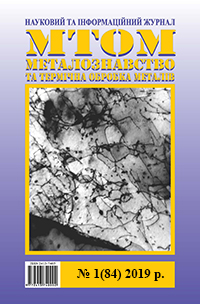Effect of scheme of rolling and post-deformation cooling on mechanical properties of rolled sheet made of V−Nb−Al-alloyed steel
DOI:
https://doi.org/10.30838/J.PMHTM.2413.260319.70.304Keywords:
, structural steel, sheet rolling, rolling, accelerated cooling, mechanical propertiesAbstract
Problem statement. Structural steel products are the bulk of the production of modern metallurgy. It is advisable to increase the mechanical properties of rolled products in the framework of technologies involving the use of rolling heating, which saves energy and reduces the production cost. Purpose. The choice of a rational scheme of rolling and post-deformation cooling of rolled steel made of structural steel. Material and Methods. The study material is 20 mm thick sheet steel made of S355J2 steel (EN 10025) micro-alloyed with V−Nb−Al complex. Methodology − tests for mechanical properties according to the requirements of EN 10025. Results. The mechanical properties of sheet metal are compared after performing standard hot rolling, normalizing rolling, controlled rolling, and also after controlled rolling with subsequent accelerated cooling in various modes. Conclusions. It is shown that by using controlled rolling with accelerated cooling to 460…530 °C, it is possible to significantly (by one third, up to category 500Q) increase the strength of steel with an increase in its cold resistance and at the same time maintaining plasticity at an acceptable level. Such an increase in the complex of properties is achieved without the use of heat treatment with special heating, which is an economically advantageous direction.
References
Сталь для магистральных газопроводов / [Ю. И. Матросов, Д. А. Литвиненко, С. А. Голованенко]. – Москва : Металлургия, 1989. – 288 с. – Режим доступа : http://bwbooks.net/index.php?id1=4&category=metallurgiya&author= matrosov-ui&book=1989 2. Большаков В. И. Влияние режимов контролируемой прокатки на структуру и свойства низкоуглеродистой микролегированной стали 10Г2ФБ / В. И. Большаков, Г. Д. Сухомлин, Д. В. Лаухин, А. В. Бекетов, Н. В. Сахник, Е. М. Кузмичев, А. А. Тараненко, Ю. М. Снежковская // Строительство, материаловедение, машиностроение. – 2009. – Вып. 48, ч. 3. – С. 237–242. – Режим доступа : http://oaji.net/articles/2017/2528-1507198792.pdf 3. Laber K. The effect of the normalizing rolling of S355J2G3 steel round bars on the selected mechanical properties of finished product / K. Laber, H. Dyja // Solid State Phenomena. – 2010. – Vol. 165. – Pp. 294–299. – Режим доступа : http: //citeseerx.ist.psu.edu/viewdoc/download?doi=10.1.1.429.5182&rep=rep1&type=pdf 4. Zhao M. C. The effects of thermomechanical control process on microstructures and mechanical properties of a commercial pipeline steel / M. C. Zhao, K. Yang, Y. Y. Shan // Materials Science and Engineering A. – 2002. – Vol. 335. – Pp.14–20. – Режим доступа : https://www.sciencedirect.com/science/article/abs/pii/S0921509301019049 5. Lan L. Phase transformation, microstructure, and mechanical properties of X100 pipeline steels based on TMCP and HTP concepts / L. Lan, Z. Chang, X. Kong, C. Qiu, D. Zhao // Journal of Materials Science. – 2017. – Vol. 52. – Pp. 1661–1678. – Режим доступа : https://link.springer.com/article/10.1007/s10853-016-0459-6 6. Lee J. Review of accelerated cooling of steel plate / J. Lee, S. Samanta, M. Steeper // Ironmaking & Steelmaking. – 2017. – June. – Pр. 268–273. – Режим доступа : https://www.tandfonline.com/doi/abs/10.1080/1743281215Y.0000000010a?journal Code=yirs20 7. Matrosov M. Y. A study of the microstructure of niobium-microalloyed pipe steel after different modes of controlled rolling with accelerated cooling / M. Y. Matrosov, L. I. Efron, A. A. Kichkina, I. V. Lyasotskii // Metal Science and Heat Treatment. – 2008. – Vol. 50. – Pp. 44–49. – Режим доступа : https://link.springer.com/article/10.1007/s11041-008-9034-3
Downloads
Published
Issue
Section
License
Authors that are published in this journal agree to follow the conditions:
Authors reserve the right to the authorship of his work and cede the right to the journal of first publication of this work on conditions of the license under the Creative Commons Attribution License, which allows others to distribute it freely with the obligatory reference to the author of the original work and the first publication of the work in this journal.

